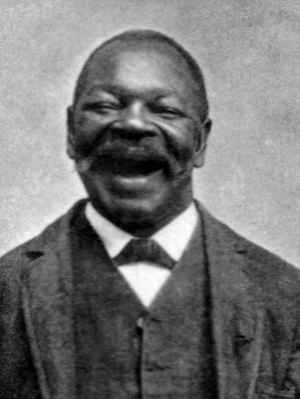


George Johnson
Source: Library of Congress
Born circa Oct 1846 in Virginia, George W. Johnson was a minstrel and vaudeville singer believed to be the first black to record. Johnson authority, Tim Brooks, has proffered the possibility that Johnson may have made tinfoil recordings for Thomas Edison as early as 1878. Edison first discovered that tinfoil could be grooved to record sound in 1877. After a couple of years he abandoned that approach to work on the light bulb, then returned to recording again in 1887, finding wax cylinders more successful.
Johnson began putting away tracks for the Metropolitan Phonograph Company of New York in 1890, evidence of which is a refund for a defective cylinder of 'The Laughing Song' registered on 22 May 1890. 'The Whistling Coon' went down in 1890 as well. Come the New Jersey Phonograph Company in 1891 while performing in Manhattan, additional versions of 'The Laughing Song' and 'The Whistling Coon'. Those were followed by tracks for Edison issued by the New York Phonograph Company, his first gone down on 1 June 1891 (one day before George Gaskin's first titles for Edison on the New York label). Those were also 'The Laughing Song' w 'The Whistling Coon'. Those being best-sellers for Johnson, he repeatedly documented endless versions of each, usually together, during his brief recording career from 1890 to as late as circa 1909-1910 for United States Everlasting on cylinders 324 and 358. Relevantly, Tim Gracyk comments that since early cylinder recordings weren't reproducible, multiple masters were made with multiple grooving machines to ten and upward lined up to record a performance. This difficulty in the dissemination of early popular music at that time required that Johnson record his titles again and again, getting paid twenty cents per two minutes of recording. Fifty recordings a day might have stacked up to, say, around ten dollars, but the repetitive takes of the same titles must have presented a task to inspiration for both Johnson and his pianist. Another peculiarity in early recording at this time was its initial absence of both matrix and issue numbers, making it more difficult for discographers to gather data.
Per immediately below, Jordan identifies 'The Whistling Coon' as the first recording by an African American in 1891. Per above, Johnson did scratch that in June of 1891. But the first recording by an African American was, per above, prior to May of 1890, which sessionography by Tim Brooks identifies as 'The Laughing Song' and 'The Whistling Coon'.
'The Whistling Coon' George Johnson
Recorded prior to May 1890 in NYC if this is the first recording by an African American
That would be for the Metropolitan Phonograph Company of New York
Recorded 1 June 1891 in West Orange NJ if this is 1891
That would be an Edison recording issued by the New York Phonograph Company
Composition: Sam Devere
'The Laughing Song' George Johnson
Recorded sometime prior to April 1891
Composition: George Johnson
Johnson at the vanguard of early cylinder recording also made him among the first to record on flat disc. DAHR begins its sessionography of Johnson on disc per 'Whistling Coon' on Berliner 196 from a session on 8 October 1894. I've not identified any earlier tracks for Berliner. The Berliner label was the first to distribute disc recordings, founded by Emile Berliner who had also invented disc recording and the gramophone in Washington D.C. in 1887. Data such as titles and performers on the earliest records was handwritten on each individual disc, a job that would soon disappear with label printing. Johnson also recorded on flat disc for Victor, Columbia, Okeh, Zonophone and Leeds & Catlin, the last in NYC in late 1905 or early 1906 toward 'Whistling Song' and 'The Whistling Girl'.
Johnson's renditions of 'The Laughing Song' and 'The Whistling Coon' remained popular as the calendar rolled into the 20th century. But that wouldn't last. Tim Brooks' sessionography traces Johnson on flat disc to as late as 1908 upon 'Negro Laughing Song' with one backed by orchestra, the other with the usual accompaniment by piano alone. See Columbia A297 in 1908. Johnson recorded 'The Laughing Song' and 'The Whistling Coon' a final time in 1909 or 1910, those issued on cylinder per U.S. Everlasting 324 and 358. See also Hind Quarter below.
'Negro Laughing Song' George Johnson
Recorded 1908 toward Columbia A297
Composition: George Johnson
Exchanging the life of a popular recording star for that of an office doorman, Johnson as 67 years old upon his death on 13 January 1914. Although he had never married, he had had a couple of common law wives. The first was an unknown German woman found dead in the apartment she shared with him in 1894 or 1895 for which Johnson wasn't charged. The second died on 22 October 1899 upon being beaten in an apartment shared with Johnson, for which he went to trial and was acquitted.
Sources & References for George Johnson:
Tim Brooks (Lost Sounds / University of Illinois Press 2004)
Tim Brooks (website)
Allan Sutton (recollections of the N.J. Phonograph Co by Victor Emerson & John Bieling)
VF History (notes)
Audio: UCSB Cylinder Audio Archive
Documentaries: Nathaniel Jordon (2020)
Murder Trial of George Johnson (1899): Ramona S. Baker (See also Lost Sounds by Tim Brooks 2004)
New Jersey Phonograph Company: Allan Sutton (See also Lost Sounds by Tim Brooks 2004)
New York Phonograph Company: ARSC Blog
North American Phonograph Company: Wikipedia
The First Book of Phonograph Records (NAPC 1889): ARSC Blog
Recordings on Berliner:
45 Worlds (issues)
DAHR (sessons)
ODP (sessions)
United States Gramophone Company (first Berliner catalogue 1 November 1894)
Recordings by George Johnson:
45 Worlds (issues)
Tim Brooks (sessions)
DAHR (sessions)
Discogs (issues)
Hind Quarter (sessions)
RYM (issues)
Repertoire (mentioned above):
The Whistling Coon: Musiqology RYM
Further Reading:
Blackface Minstrelsy:
George Johnson: John Adcock Tim Gracyk Internet Archive
Vaudeville:
Classical Main Menu Modern Recording
hmrproject (at) aol (dot) com